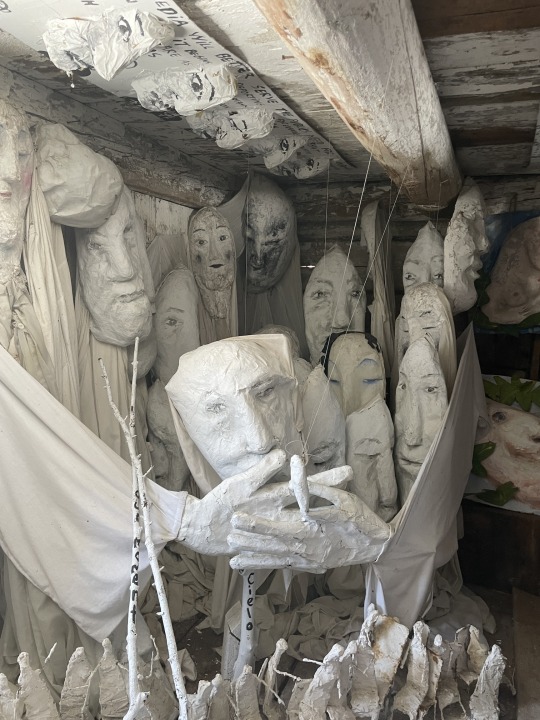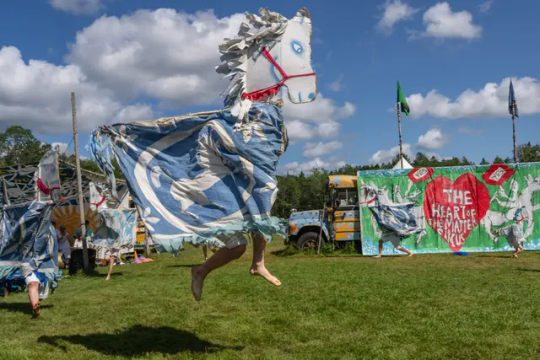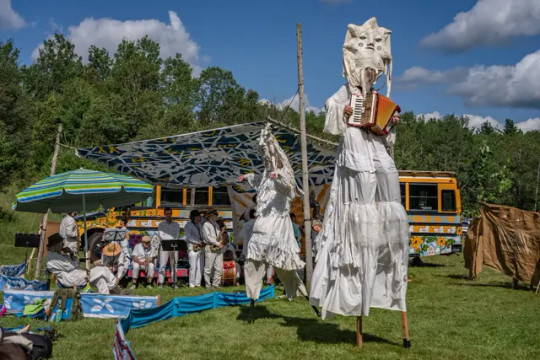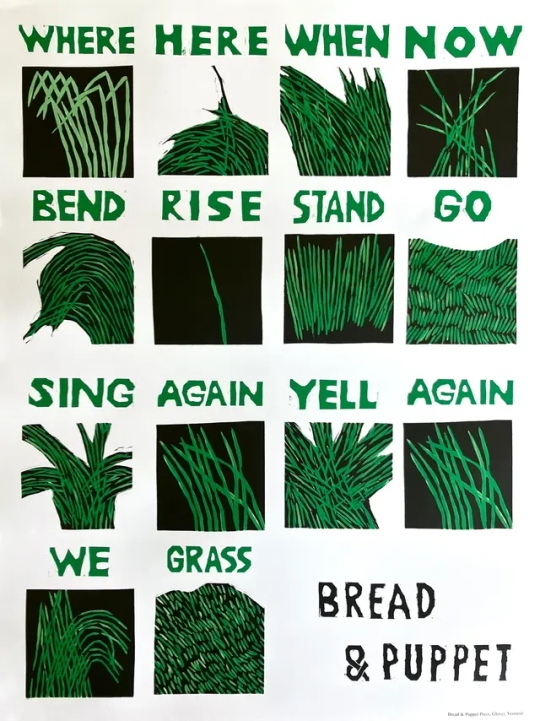#peter schumann
Explore tagged Tumblr posts
Text

The Bread and Puppet Theater, Peter Schumann, New York, 1962
#peter schumann#1962#1960s art#early 1960s#mid 20th century#art#photo#arte#kunst#photography#bread#puppet#bread and puppet#vintage#history#art history#history of art#artwork#obra de arte#kunstwerk#1960s#new york#bread and puppet theater#theater#theatre
39 notes
·
View notes
Text






Bread & Puppet Theater, Glover Vermont
#bread & puppet#politically radical puppet theater#anti capitalism#puppets#Peter Schumann#Erika Schumann
20 notes
·
View notes
Text



INSIDE A BARN last month, a couple of hours after the rehearsal for the “Heart of the Matter” pageant, several dozen performers from around the world — paid puppeteers, interns, community volunteers — presented their proposed circus acts. Schumann typically reviews and critiques the sketches.
Most of the acts had a whimsical tone. A man imitating a bee (collapsing bee colonies the inspiration) did a frenetic waggle around a cardboard city that transformed itself into a tangle of dancing urbanites. An orca ambushed yachting billionaire puppets. When somber-looking tree figures appeared with a narrator reading facts about boreal forests versus the more flammable monoculture ones burning in nearby Canada, Schumann became agitated.
“It’s too cliché, something everyone already knows,” he shouted. “You have to stop using so many words and solve things puppetry-wise.” Then he jumped to his feet and started moving people and puppets around. He had puppeteers throw the trees and then dance with them, causing some confusion.
“It’s what you do, not what you say,” he said. “It’s puppetry, not preaching.”
He told them he would return in a half-hour to see a revision. Then, as dinnertime approached, he excused himself to help the kitchen staff make potato pancakes — a recipe from his war-torn childhood.
With admirable control, the puppeteers discussed how to rework their savaged piece, each giving the others time to suggest solutions. It was a utopian vision of collaboration, agile and practical — and typical of how the company functions.
“Peter has a strong directional voice,” said Ziggy Bird, 26, a company member who took notice of Schumann’s work in a theater history class at Temple University. “It’s never personal and some of the most beautiful moments come from frustration, which can be a kick in the pants.”
+
[from comments]
In 1970, Father Daniel Berrigan was on the FBI's 10 most wanted list for his anti-war activities which led to a conviction and then his failure to show up for prison. A major event supporting Berrigan, after he became a refugee, was held in Ithaca.
The FBI was there waiting. The question was whether Berrigan would appear and speak to the thousands in the audience.
I was a stage hand and watched Berrigan enter the stage, unrecognized as he wore a motorcycle helmet. He removed the helmet to cheers and gave a speech. The FBI probably figured that they would avoid a riot and grab him as he left the building.
But then, from the back of the huge arena (Barton Hall), came chanting, weird music and lights. It was The Bread and Puppet Theater to the rescue. The ten foot puppets moved about as weirdness took over. Berrigan was alone on the stage, when the giant puppets came on stage and swirled around him in a spiral. I think I was the only one who noticed, from my stage hand perspective, as Berrigan slipped inside one of the puppets as the swirl unwound itself and kept chanting as they left the arena.
It took the FBI another seven months to catch up to Father Berrigan and send him to prison. I believe that this was one of the greatest puppet shows in history.
Yet, this is a story that few know about. Berrigan really was on the FBI's 10 Most Wanted list. and The Bread and Puppet Theater squirrelled him away to safety.
82 notes
·
View notes
Text
Sunday Homily: Jesus As Prophetic Bread of Life
Bread & Puppet’s rendition of El Salvador’s martyred archbishop, Oscar Romero Readings for the 19th Sunday in Ordinary Time: I Kgs. 19:4-8; Eph. 4:30-5:2; Jn. 6:41-51 This Sunday’s readings are about prophets and bread. They remind me of a recent visit my wife Peggy and I made to Glover Vermont’s Bread and Puppet Museum along with two of our eight grandchildren, Eva (age 15) and Orlando (12).…

View On WordPress
#Bread & Puppet Museum#Bread & Puppet Theater#Elka Schumann#God#Homiletic helps#Jesus#Peter Schumann#Prophecy#religion#Spirituality#Sunday Homilies
0 notes
Text

Peter Leibing | Konrad Schumann
27 notes
·
View notes
Text
Igor Cognolato, Klavier
85. Hauskonzert bei Familie Löning Igor Cognolato, Klavier Lingen (Ems) – Emsphilharmonie, Falkenstraße 17 Samstag, 04. November 2023 – 19 Uhr Wie immer: Kein Eintritt, Spende erbeten
85. Hauskonzert bei Familie Löning Igor Cognolato, Klavier Lingen (Ems) – Emsphilharmonie, Falkenstraße 17 Samstag, 04. November 2023 – 19 Uhr Wie immer: Kein Eintritt, Spende erbeten Anmeldung erforderlich: info(at)lingener-hauskonzerte.de “Auf einen Besuch des italienischen Pianisten Igor Cognolato hoffen wir schon sehr lang. Nun ist es endlich soweit. Es gibt an diesem Abend Klaviermusik von…
View On WordPress
0 notes
Text
Writing Notes: Classical Music Eras

Classical Music - describes orchestral music, chamber music, choral music, and solo performance pieces, yet within this broad genre, several distinct periods exist. Each classical era has its own characteristics that distinguish it from classical music at large.
Eras of Classical Music
Musicologists divide classical music into historical eras and stylistic subgenres. One way to examine classical music history is to divide it into 7 periods:
Medieval period (1150 to 1400): Music has existed since the dawn of human civilization, but most music historians begin cataloging classical music in the Medieval era. Medieval music is known for monophonic chant—sometimes called Gregorian chant due to its use by Gregorian monks. In addition to singing, Medieval musicians played instrumental music on instruments like the lute, the flute, the recorder, and select string instruments.
Renaissance period (1400 to 1600): Renaissance-era music introduced polyphonic music to wide audiences, particularly via choral music, which was performed in liturgical settings. In addition to the lute, Renaissance musicians played viol, rebec, lyre, and guitar among other string instruments. Brass instruments like the sackbut and cornet also emerged during this era. Perhaps the most notable Renaissance composers were Giovanni Pierluigi da Palestrina, John Dowland, and Thomas Tallis.
Baroque period (1600 to 1750): During the Baroque era, classical music surged forward in its complexity. The Baroque era saw a full embrace of tonal music—music based on major scales and minor scales rather than modes—and it maintained the polyphony of the Renaissance era. Many of the instruments used by today's orchestras were common in Baroque music, including violin, viola, cello, contrabass (double bass), bassoon, and oboe. Harpsichord was the dominant keyboard instrument, although the piano first emerged during this era. The most renowned composers of the early Baroque era include Alessandro Scarlatti and Henry Purcell. By the late Baroque period, composers like Antonio Vivaldi, Dominico Scarlatti, George Frideric Handel, and Georg Philipp Telemann achieved massive popularity. The most influential composer to come from the Baroque era is Johann Sebastian Bach, who composed extensive preludes, fugues, cantatas, and organ music.
Classical period (1750 to 1820): Within the broad genre of classical music exists the Classical period. This era of music marked the first time that the symphony, the instrumental concerto (which highlights virtuoso soloists), and the sonata form were brought to wide audiences. Chamber music for trio and string quartet was also popular during the Classical era. The signature classical composer is Wolfgang Amadeus Mozart, although he was far from the only star of the classical era. Joseph Haydn, Franz Schubert, and J.S. Bach's sons J.C. Bach and C.P.E. Bach were also star composers during this period. Opera composers like Mozart and Christoph Willibald Gluck developed the operatic form into a style that remains recognizable today. Ludwig van Beethoven began his career during the Classical era, but his own innovations helped usher in the next musical era.
Romantic period (1820 to 1900): Exemplified by late-period Beethoven, the Romantic era introduced emotion and drama to the platonic beauty of Classical period music. Early Romantic works like Beethoven's Symphony No. 9 set a template for nearly all nineteenth-century music that followed. Many of the composers who dominate today's symphonic repertoires composed during the Romantic era, including Frederic Chopin, Franz Liszt, Felix Mendelssohn, Hector Berlioz, Robert Schumann, Johannes Brahms, Anton Bruckner, Gustav Mahler, Peter Ilyich Tchaikovsky, Richard Strauss, Jean Sibelius, and Sergei Rachmaninoff. Opera composers like Richard Wagner, Giuseppe Verdi, and Giacomo Puccini used Romanticism's emotional power to create beautiful melodic lines sung in Italian and German. The Romantic era also saw the creation of a new instrument in the woodwind family, the saxophone, which would gain special prominence in the century to come.
Modern period (1900 to 1930): The Modern era of art and music came about in the early twentieth century. Classical composers of the early twentieth century reveled in breaking the harmonic and structural rules that had governed previous forms of classical music. Igor Stravinsky defiantly stretched instruments to their natural limits, embraced mixed meter, and challenged traditional notions of tonality in works like The Rite of Spring. French composers like Claude Debussy and Maurice Ravel led a subgenre of twentieth-century music called Impressionism. Others like Dimitri Shostakovich, Paul Hindemith, and Béla Bartók stuck with classical forms like the piano concerto and the sonata, but challenged harmonic traditions. Perhaps most radical was the German composer Arnold Schoenberg who, along with disciples like Alban Berg and Anton Webern, disposed of tonality altogether and embraced serial (or 12-tone) music.
Postmodern period (1930 to today): The art music of the twentieth century shifted starting in the 1930s and continuing into the post-World War II era, ushering in a style of music that is sometimes called postmodern or contemporary. Early purveyors of postmodern music include Olivier Messiaen, who combined classical forms with new instruments like the ondes martenot. Postmodern and contemporary composers like Pierre Boulez, Witold Lutoslawski, Krzysztof Penderecki, Henryk Górecki, György Ligeti, Philip Glass, Steve Reich, John Adams, and Christopher Rouse have blended the lines between tonal and atonal music, and they’ve blurred the lines between classical music and other forms like rock and jazz.
Source ⚜ More: Notes & References ⚜ Writing Resources PDFs
#classical music#writing notes#music#writeblr#history#writing inspiration#writing reference#writing ideas#literature#writers on tumblr#worldbuilding#dark academia#spilled ink#classic#writing prompt#creative writing#writing resources
95 notes
·
View notes
Text
Eduard Wirths was the chief SS doctor (SS-Standortarzt) at the Auschwitz concentration camp from September 1942 to January 1945. Thus, Wirths had formal responsibility for everything undertaken by the nearly twenty SS doctors (including Josef Mengele, Horst Schumann and Carl Clauberg) who worked in the medical sections of Auschwitz between 1942 and 1945.
Wirths was captured by the Allies at the end of the war and held in custody by British forces. Later, on 20 September 1945, knowing that he would face trial for war crimes, Wirths committed suicide by hanging.[14]
In 2014 Wirths' son Peter donated his father's photo albums to the USHMM – these contain photos of the Wirths family at the Solahütte, Wirths with Rudolf Höss, pictures of the old village of Birkenau before it was destroyed and pictures of the building of the SS hospital at Auschwitz.
Robert Jay Lifton has said that
". . . Wirths was significantly immersed in Nazi ideology in three crucial spheres: the claim of revitalizing the German race and Volk; the biomedical path to that revitalization via purification of genes and race; and the focus on the Jews as a threat to this renewal, to the immediate and long-term "health" of the Germanic race. While Wirths did not absolutize these convictions in the manner of Mengele — they were in him combined with a strong current of medical humanism — his commitment to the Nazi cause was probably no less strong . . ."
Perhaps illustrative of Wirths' commitment to medical 'leadership' was his tendency while at Auschwitz to drive about in a car flying a Red Cross flag as well as his enthusiasm for acting as a marriage counselor and personal adviser to other SS personnel. According to Helgard Kramer,
". . . first seized on a career as a military doctor and officer in the German elite troops of the SS, because he desperately wanted to become a member of the upper class; eventually to provide his future wife with a "decent marriage". To reach that goal he had to become a "tough man"..."
Wirths sucked on the nazi teat and then was a coward and refused to face his crimes.

13 notes
·
View notes
Text
ENCONTRE UM AUTOR:
Envie sugestões. Leia uma citação no modo aleatório.
Autores Desconhecidos
Adélia Prado
Adrian Tchaikovsky
Affonso Romano de Sant’anna
Alain de Botton
Albert Einstein
Aldous Huxley
Alexander Pushkin
Amanda Gorman
Anaïs Nin
Andy Warhol
Andy Wootea
Anna Quindlen
Anne Frank
Antoine de Saint-Exupéry
Aristóteles
Arnaldo Jabor
Arthur Schopenhauer
Augusto Cury
Ben Howard
Benjamin Alire Sáenz
Benjamin Rush
Bill Keane
Bob Dylan
Brigitte Nicole
C. JoyBell C.
C.S. Lewis
Carl Jung
Carlos Drummond de Andrade
Carlos Fuentes
Carol Ann Duffy
Carol Rifka Brunt
Carolina Maria de Jesus
Caroline Kennedy
Cassandra Clare
Cecelia Ahern
Cecília Meireles
Cesare Pavese
Charles Baudelaire
Charles Chaplin
Charlotte Nsingi
Cheryl Strayed
Clarice Lispector
Claude Debussy
Coco Chanel
Connor Franta
Coolleen Hoover
Cora Coralina
Czesław Miłosz
Dale Carnegie
David Hume
Deborah Levy
Djuna Barnes
Dmitri Shostakovich
Douglas Coupland
Dream Hampton
E. E. Cummings
E. Grin
E. Lockhart
EA Bucchianeri
Edith Wharton
Ekta Somera
Elbert Hubbard
Elizabeth Acevedo
Elizabeth Strout
Emile Coue
Emily Brontë
Ernest Hemingway
Esther Hicks
Faraaz Kazi
Farah Gabdon
Fernando Pessoa
Fiódor Dostoiévski
Florbela Espanca
Franz Kafka
Frédéric Chopin
Fredrik Backman
Friedrich Nietzsche
Galileu Galilei
Georg Wilhelm Friedrich Hegel
George Orwell
Hafiz
Hanif Abdurraqib
Helen Oyeyemi
Henry Miller
Henry Rollins
Hilda Hilst
Iain Thomas
Immanuel Kant
Jacki Joyner-Kersee
James Baldwin
James Patterson
Jane Austen
Jean Jacques Rousseau
Jean Rhys
Jean-Paul Sartre
Jeremy Hammond
JK Rowling
João Guimarães Rosa
Joe Brock
Johannes Brahms
John Banville
John C. Maxwell
John Green
John Wooden
Jojo Moyes
Jorge Amado
José Leite Lopes
Joy Harjo
Juan Ramón Jiménez
Juansen Dizon
Katrina Mayer
Kurt Cobain
L.J. Smith
L.M. Montgomery
Leo Tolstoy
Lisa Kleypas
Lord Byron
Lord Huron
Louise Glück
Lucille Clifton
Ludwig van Beethoven
Lya Luft
Machado de Assis
Maggi Myers
Mahmoud Darwish
Manila Luzon
Manuel Bandeira
Marcel Proust
Margaret Mead
Marina Abramović
Mario Quintana
Mark Yakich
Marla de Queiroz
Martha Medeiros
Martin Luther King
Mary Oliver
Mattia
Maya Angelou
Mehdi Akhavan-Sales
Melissa Cox
Michaela Chung
Miguel de Cervantes Saavedra
Mitch Albom
N.K. Jemisin
Neal Shusterman
Neil Gaiman
Nicholas Sparks
Nietzsche
Nikita Gill
Nora Roberts
Ocean Vuong
Osho
Pablo Neruda
Patrick Rothfuss
Patti Smith
Paulo Coelho
Paulo Leminski
Perina
Peter Ilyich Tchaikovsky
Phil Good
Pierre Ronsard
Platão
Poe
R.M. Drake
Raamai
Rabindranath Tagore
Rachel de Queiroz
Ralph Emerson
Raymond Chandler
René Descartes
Reyna Biddy
Richard Kadrey
Richard Wagner
Ritu Ghatourey
Roald Dahl
Robert Schumann
Roy T. Bennett
Rumi
Ruth Rendell
Sage Francis
Séneca
Sérgio Vaz
Shirley Jackson
Sigmund Freud
Simone de Beauvoir
Spike Jonze
Stars Go Dim
Steve Jobs
Stephen Chbosky
Stevie Nicks
Sumaiya
Susan Gale
Sydney J. Harris
Sylvester McNutt
Sylvia Plath
Sysanna Kaysen
Ted Chiang
Thomas Keneally
Thomas Mann
Truman Capote
Tyler Knott Gregson
Veronica Roth
Victor Hugo
Vincent van Gogh
Virgílio Ferreira
Virginia Woolf
Vladimir Nabokov
Voltaire
Wale Ayinla
Warsan Shire
William C. Hannan
William Shakespeare
Wolfgang Amadeus Mozart
Yasmin Mogahed
Yoke Lore
Yoko Ogawa
333 notes
·
View notes
Text

David Watkin
Cellist who co-founded the Eroica Quartet and won awards for his recording of Bach’s six solo Suites
In 2013 David Watkin, who has died aged 60 from complications caused by the autoimmune disease schleroderma, recorded the six Suites for solo cello by JS Bach. The following year his illness compelled him to step back from a distinguished performing career to become head of strings, and later professor of chamber music, at the Royal Conservatoire of Scotland in Glasgow.
When the CD set of the Suites was released in 2015, it proved to be an instant success, winning awards from Gramophone – which this year rated it as one of the 50 greatest Bach recordings – and BBC Music Magazine. His rhythmically alive, tonally beautiful and scholarly playing was realised by using a baroque bow by John Waterhouse and two historic cellos, one by Francesco Rugeri from around 1670 for the first five Suites, and a five-stringed instrument by the Amati brothers, Antonio and Girolamo, for the Sixth Suite.
As well as teaching, he continued to conduct such ensembles as the Royal Scottish National Orchestra, Academy of Ancient Music, Swedish Baroque Orchestra and Scottish Chamber Orchestra.
Born in Crowthorne, Berkshire, David came from a musical family. His parents, Christine (nee Horney) and Ken Watkin, were violin teachers, and his elder brother, Simon, gravitated to the viola. When the family were living in Beckenham, Kent, he began taking cello lessons with a local teacher, eventually enabling the family to play quartets by Haydn and Mozart.
When David was nine, the Watkin family moved again, to Pembrokeshire, where his mentors were Bridget Jenkins and the recitalist Sharon McKinley. He became the star cellist of the West Glamorgan Youth Orchestra, and went on to be a member of the National Youth Orchestra, and its principal cellist for two years.
At 15 he won a scholarship to Wells Cathedral school, where he studied the cello with Margaret Moncrieff and Amaryllis Fleming. There he encountered historically informed recordings directed by Nikolaus Harnoncourt and Frans Brüggen, and a friend’s father made him a baroque cello.
Vocal lessons from the tenor Kenneth Bowen led to his seriously considering a career as a singer. His gap year was spent as a lay clerk, singing in the choir at St Catharine’s College, Cambridge, where he went on to take a music degree (1984-87). He continued cello studies with William Pleeth and played in the Cambridge Baroque Camerata.
As a full-time performer he led the cello sections of the Orchestre Révolutionnaire et Romantique, English Baroque Soloists, Orchestra of the Age of Enlightenment, Philharmonia Orchestra and Scottish Chamber Orchestra. Other ensembles he conducted included the Malta Philharmonic and Manchester Consort, and he had a stint as assistant conductor at Glyndebourne.
While working with John Eliot Gardiner in the Orchestre Révolutionnaire et Romantique, he and three colleagues – Peter Hanson, Lucy Howard and Gustav Clarkson – felt they should adapt the orchestra’s authentic styles for Romantic music to quartet playing. Thus in 1993 the Eroica Quartet was born.
youtube
Watkin adopted a transitional approach with this ensemble, playing with an endpin: until the mid-19th century cellists had held the instrument unsupported between their legs. The quartet’s recordings of Beethoven, Mendelssohn (the quartets and the original version of the Octet), Schumann, Debussy and Ravel brought fresh perspectives to listeners. Characteristic of their approach for the Mendelssohn quartets was studying the bowings and fingerings adopted by Ferdinand David, the first performer of the composer’s Violin Concerto, for his own ensemble, and the selective application of vibrato for expressive effect. Tours took them to France and the US, and they gave Beethoven cycles in the UK and abroad.
With various colleagues, Watkin recorded concertos and sonatas by Vivaldi and sonatas by Boccherini. He and the fortepianist Howard Moody recorded three sonatas by Beethoven (1996), and to the book Performing Beethoven (2011) he contributed an essay on those works. In an article in the journal Early Music (1996) Watkin pointed to how Corelli allowed for the possibility of violin sonatas being accompanied by a string bass without a keyboard, by filling out the chords indicated by the numbers of the figured bass, and extended the principle to recitative passages in opera.
As a teacher he aimed to lead students to think for themselves. An extract from a masterclass on Bach given at Kings Place, London, in 2017 can be seen on YouTube. In choosing Watkins’ Bach recordings for its 50 best, Gramophone commented on the “warm, expansive, generous and friendly” character of the playing, and many found the same qualities in him as a colleague.
In 2002 Watkin married Sara Burton, and they had two sons, Noah and Sandy. They separated, and he is survived by his partner, Lisi Stockton, his sons, his parents and Simon.
🔔 David Watkin, cellist, conductor, musicologist and teacher, born 8 May 1965; died 13 May 2025
Daily inspiration. Discover more photos at Just for Books…?
4 notes
·
View notes
Note
Hi !
I'm also a dark academia lover. Can you share some playlist ides for dark academia vibe
Absolutely!
For classic music: Passacaglia by Handel/Halvorsen; Nocturne by Chopin; Moonlight by Beethoven; Lacrimosa by Mozart; Dining with Lectre by Peter Gundry; Bach's Tocatta and Fugue in D minor. Also Bach's Prelude for Lute in C minor. Basically anything Mozart, Bach, Beethoven, Claude Debussy, Hadyn, Wagner, Chopin, Giazotto, Schumann, and Lizst.
For modern music : Anything by Hozier, The Gang of Youths, songs like The Cult of Dionysus by The Orion Express, and Brutus by The Buttress. Some of Lorde, Ethel Cain, some Lana del Rey, also Sufjan Stevens for his really sad tracks.
For movie soundtracks: Pride and Prejudice 2005, Maurice (1987), Penny Dreadful' (2014 - 2016), Black Swan (2010), Jane Eyre 2011, Portrait of a Lady on Fire 2019, The Theory of Everything (2014), Kill Your Darlings (2013), Ginger and Rosa, Wuthering Heights 2011, Little Women 2019, The Young Victoria, The Duchess, Belle. Just to name a few!
#dark academia#light academia#romantic academia#classic academia#dark academia aesthetic#dark academia vibes#dark academia music#academia#studyblr#light academia aesthetic#aesthetic#chaotic academia#literature academia#academia music
61 notes
·
View notes
Text
Peter Schumann and Bread and Puppet Theater are so much a part of my own work in theatre. They were 'in residence' several times when I was in college. I saw them perform again when I lived in NYC and saw them again, performing on the streets of downtown Atlanta. I took my mother and two young siblings who were visiting. They were and are like nothing else in the theatre world. The conviction and precision of their performance is riveting. What a life Peter Schumann has had, living his own very powerful vision. Like Peter Brook, his message of theater and performance wasn't so much about "putting on a show" but about living out of your own inner convictions and expressing that inner soul-self with exact artistry.
3 notes
·
View notes
Photo

East German police officer, Conrad Schumann, escaping from East to West Berlin (1961).
Peter Leibing
57 notes
·
View notes
Text

East German border guard Konrad Schumann leaping over barbed wire to defect to West Germany during construction of the Berlin Wall.
Photographer: Peter Leibing. 15 August 1961.
15 notes
·
View notes
Text

gay pirate brianrot (our flag means death)
just straight up vibes, mate
the chain - fleetwood mac
sweet creature - harry styles
could have been me - the struts
here i go again - whitesnake
love is gone (acoustic) - SLANDER, dylan matthew
let me follow - son lux
achilles come down - gang of youths
till forever falls apart - ashe, FINNEAS
i found - amber run
achilles heel - j. maya
pierre - ryn weaver
partners in crime - set it off, ashe costello
motion sickness - phoebe bridgers
arms unfolding - dodie
sea of love - cat power
hello hello - elton john
ready now - dodie
love like you - caleb hayes
this will be (an everlasting love) - natalie cole
abcdefu (angrier) - GAYLE
would you go with me - josh turner
if i ain't got you - alicia keys
ship in a bottle - fin
underground - cody fry
one (mono single version) - harry nilsson
simply the best - billianne
miss missing you - fall out boy
burn butcher burn - joey batey
in case you don't live forever - ben platt
never love an anchor - the crane wives
inkpot gods - the amazing devil
ruin - the amazing devil
i guess i'm in love - clinton kane
chicken tendies - clinton kane
like real people do - hozier
seven - taylor swift
our prayer - the beach boys
hallucinogenics - matt maeson
crazy on you - heart
locomotive breath - jethro tull
high on a rocky ledge - moondog
messa da requiem: 2. dies irae - guiseppe verdi, berliner philharmoniker, carlo maria guilini, ernst senff chor
sonata in e major, k. 380 - domenico scarlatti, khatia buniatishvili
gnossienne no. 5: modéré - erik satie, olga scheps
concerto for recorder and viola dagamba in a minor, twv 52:a1: I.grave - georg philipp telemann, hille perl
II triello - ennio morricone
perfect day - lou reed
träumerei (kinderderszenen, op. 15) - robert schumann, ronny matthes
2 arabesques, l. 66: no. 1 in e major - claude debusy, peter frankl
rêverie, l. 68: rêverie - claude debussy, jean-yves thibaudet
avalanche - leonard cohen
miles from nowhere - yusuf / cat stevens
go to hell - clinton kane
back to december - taylor swift
mine - taylor swift
break my stride - matthew wilder
viva la vida - coldplay
blackbeard's ghost - jesse rice
back to black - amy winehouse
change (in the house of flies) - deftones
we'll never have sex - leith ross
make up your mind - florence + the machine
everybody loves me - onerepublic
the captain's daughter - alison krauss & union station
easy on me - adele
hoist up the thing - the longest johns
gimme! gimme! gimme! (a man after midnight) - abba
right where you left me - taylor swift
super trouper - abba
soldier, poet, king - the oh hellos
raise hell - brandi carlile
ocean blue - moniker
no choir - florence + the machine
leggie blonde - flight of the conchords
little lion man - mumford & sons
rolling in the deep - adele
pirate song - ben barnes
i love you like an alcoholic - the taxpayers
hello my old heart - the oh hellos
a pirate's life - joel fry
to death we go - joel fry
hurts like hell - fleurie, tommee profitt
lay all your love on me - abba
judas - lady gaga
the moon will sing - the crane wives
this side of paradise - coyote theory
shrike - hozier
enchanted - taylor swift
the night we met - lord huron
dear wormwood - the oh hellos
iris - the goo goo dolls
favorite crime - olivia rodrigo
the foundations of decay - my chemical romance
curses - the crane wives
matilda - harry styles
if i could fly - one direction
welcome home, son - radical face
the mary ellen carter - the longest johns
sweet disposition - the temper trap
like ships need the sea - emily hearn
#cj talks#clearing out my spotify#i did this on vampeddie a couple times with other playlists i wanted to get rid of but then it got nuked 😔#ofmd#our flag means death
7 notes
·
View notes
Text



WE GRASS
Print and Booklet
Color offset print of a masonite cut by Peter Schumann that reads, WE GRASS, picturing grass in various extensions of itself...
...from humble bend to triumphant yell: we grass!
Source: https://breadandpuppetpress.org/products/we-grass-1?pr_prod_strat=e5_desc&pr_rec_id=24c2cb776&pr_rec_pid=9003962040596&pr_ref_pid=8959932629268&pr_seq=uniform
11 notes
·
View notes